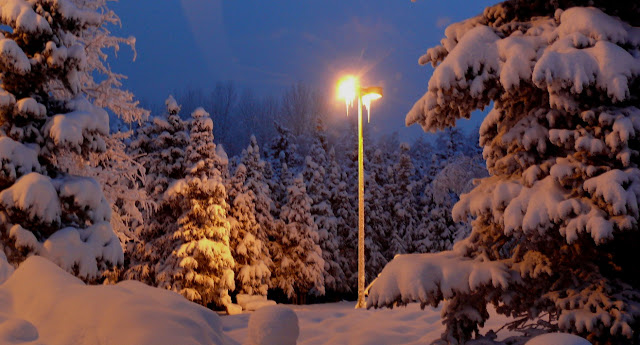Recently one of the blogs that I follow did an interesting post about woodpeckers. It got me thinking about them as well. Over the years I have had the opportunity to photogragh various species. Which is my favorite? That's hard to say, but the Pale-billed Woodpecker of central America is as impressive as any that I've seen.
Here in southcentral Alaska there are four regularly occuring species of woodpecker, Downy, Hairy, Three-toed, and Black-backed. The first two species are very common, the Three-toed less so, and the Black-backed is very hard to find. The bird in the above photo is a female Hairy Woodpecker.
The male Hairy Woodpecker has a jaunty red cap. Downy Woodpeckers are almost identical in appearance except they are smaller and have a stubbier beak.

This is the first Black-backed Woodpecker that I have seen. I was so fortunate to find a nest in the above tree. This is the male. That day was also the day I saw my first Grizzly Bear. They were both in a city park in Anchorage. The bear followed me down the trail for about 100 yards. It was quite an adrenaline rush. I got photos of the bear also.
When I lived in Arizona there were many species of woodpecker, including the Red-shafted Flicker. They prefer to eat ants, but they will even eat bird seed.
The deserts in Arizona have the Gilded Flicker.
I have seen the clown-like Acorn Woodpecker from California to Costa Rica. They are a gregarious woodpecker. Of course they specialize in eating acorns. Like many woodpeckers they have a raucous vocabulary.
A close relative of the Yellow-bellied Sapsucker, the Red-naped Sapsucker. It was a very cold day in Arizona when I photographed this female in my yard. After it had it's fill of the apple, many smaller birds rushed in to feed on the apple.
Another sapsucker species that occurs in the higher elevations of Arizona, the Williamson's Sapsucker. This is the female at the nest in an aspen tree.
The male Williamson's Sapsucker looks like a completely different species of bird.
The temperature was -10f when I shot this lousy photo of a Great Spotted Woodpecker in Caswell Lakes, Alaska.. I believe it was only the second sighting of this species in North America.
I posted this photo earlier. It's a Black-cheeked Woodpecker in Cahuita, Costa Rica.
The smallest Woodpecker that I have seen is this Grey-crowned Pygmy Woodpecker in Phang Nga, Thailand. It looked to be about the size of a White-breasted Nuthatch.
A female Bearded Woodpecker in Kruger Nat. Park, South Africa.
A female Cardinal Woodpecker, also in Kruger.
This is a bad photo of a hard to find woodpecker in South Africa, Olive Woodpecker.
My life list of woodpeckers so far.
1. Red-shafted Flicker, USA
2. Gilded Flicker, USA, Mexico
3. Downy Woodpecker, USA
4. Hairy Woodpecker, USA
5. Acorn Woodpecker, USA, Mexico, Costa Rica
6. Red-naped Sapsucker, USA
7. Williamson's Sapsucker, USA
8. Lewis' Woodpecker, USA
9. Gila Woodpecker, USA, Mexico
10. Ladder-backed Woodpecker, USA, Mexico
11. Golden-cheeked Woodpecker, Mexico
12. Red-crowned Woodpecker, Costa Rica
13. Golden-naped Woodpecker, Costa Rica
14. Hoffman's Woodpecker, Costa Rica
15. Black-cheeked Woodpecker, Costa Rica
16. Smoky Brown Woodpecker, Costa Rica
17. Rufous-winged Woodpecker, Costa Rica
18. Cinnamon Woodpecker, Costa Rica
19. Chestnut-colored Woodpecker, Costa Rica
20. Linneated Woodpecker, Mexico, Costa Rica, Peru
21. Pale-billed Woodpecker, Mexico, Costa Rica
22. Crimson-crested Woodpecker, Peru
23. Three-toed Woodpecker, USA
24. Black-backed Woodpecker, USA
25. Great Spotted Woodpecker, USA
26. Greater Flameback, Thailand
27. Cream-colored Woodpecker, Ecuador
28. Yellow-tufted Woodpecker, Ecuador
29. Heart-spotted Woodpecker, Thailand
30. Grey-capped Pygmy Woodpecker, Thailand
31. Little Woodpecker, Peru
32. Chestnut Woodpecker, Peru
33. Spot-breasted Woodpecker, Peru
34. Bearded Woodpecker, South Africa
35. Cardinal Woodpecker, South Africa
36. Bennet's Woodpecker, South Africa
37. Olive Woodpecker, South Africa.
Which species will I get to see next? That's a much anticipated thrill for me.
Thank you for indulging me with this little vanity of mine in listing these birds.


















































